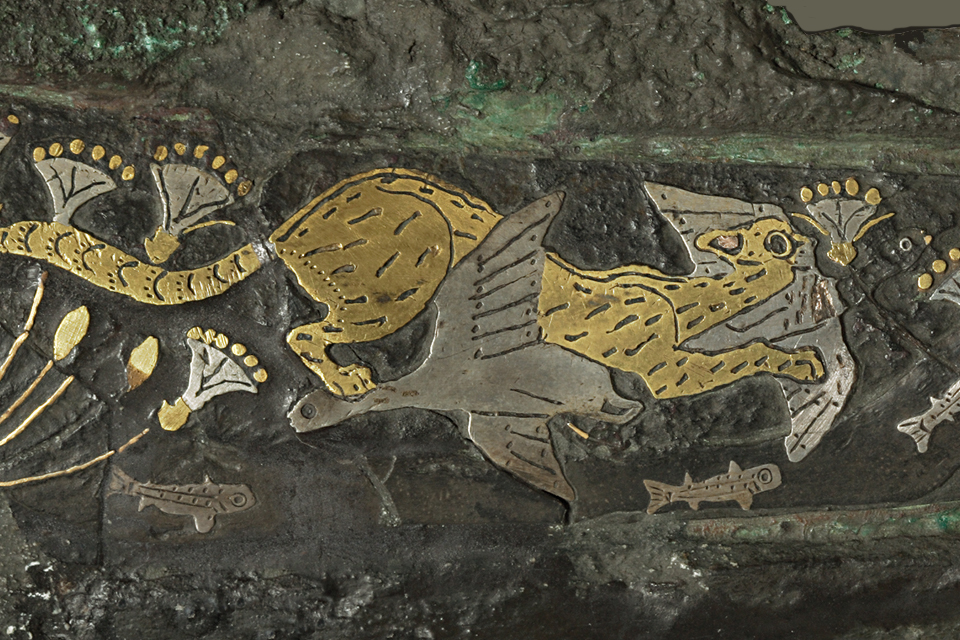Detail from a Mycenaean bronze dagger with inlaid decoration, circa 1600 BCE. (Inv. no. 765. National Archaeological Museum ofAthens. Sourceː Museum inscription.)
Ancient cultures had diverse and often unexpected attitudes towards cats. While the Egyptians famously revered these enigmatic creatures, both the Greeks and the Romans held more practical—and sometimes humorous—views. If you’re a cat lover with a penchant for ancient languages, prepare to be charmed by a journey into how feline lore meets linguistic elegance.
What is ‘cat’ in Ancient Greek? Language, art, and cultural context
The Greeks do not appear to have been especially receptive to cats—at least, not compared to the Egyptians, who had domesticated cats (or, perhaps, whom cats had domesticated) since at least 2,000 BCE.
The Greek word for cat, αἴλουρος, (‘tail-twitcher’) can refer broadly to small predators including martens. And whilst cats sometimes appear in Greek art, it is not always clear whether the cat is a wild or pet cat.
Herodotus gives us this description of cats among the Egyptians:
πυρκαϊῆς δὲ γενομένης θεῖα πρήγματα καταλαμβάνει τοὺς αἰελούρους· οἱ μὲν γὰρ Αἰγύπτιοι διαστάντες φυλακὰς ἔχουσι τῶν αἰελούρων, ἀμελήσαντες σβεννύναι τὸ καιόμενον, οἱ δὲ αἰέλουροι διαδύνοντες καὶ ὑπερθρώσκοντες τοὺς ἀνθρώπους ἐσάλλονται ἐς τὸ πῦρ. ταῦτα δὲ γινόμενα πένθεα μεγάλα τοὺς Αἰγυπτίους καταλαμβάνει. ἐν ὁτέοισι δ᾽ ἂν οἰκίοισι αἰέλουρος ἀποθάνῃ ἀπὸ τοῦ αὐτομάτου, οἱ ἐνοικέοντες πάντες ξυρῶνται τὰς ὀφρύας μούνας.
Herodotus, The Histories, 2.66
(flourished c. 484 BCE – c. 420 BCE)
If a fire breaks out, marvellous things befall the cats. The Egyptians stand at intervals keeping watch over the cats, with no thought for putting out the fire, while the cats slip through or leap over them and jump into the fire. When this happens, great mourning possesses the Egyptians. In any house where a cat dies of natural causes, all the inhabitants shave just their eyebrows.
(trans. Dr Melinda Letts)
Cats in Rome: literary references and everyday imagery
Cats are more common in ancient Roman literature, often as the troublesome predators of smaller animals.
The early comic playwright Titus Maccius Plautus (3rd-2nd Century BCE) uses the phrase feles virginaria (‘a cat prowling after maidens’) for a sexual predator in his play Persa (IV.ix.14; line 751).
Lucius Junius Moderatus Columella, who wrote on agriculture during the early Roman Empire, advises farmers to take steps to protect their chicken coops from cats, as well as from snakes and weasels. (Columella, De Re Rustica VIII.iii.6, xiv.9, xv.2).
Cats also make an appearance in one of the ‘New Fables’ of the Roman author Phaedrus. The ‘New Fables’ are fables that don’t seem to have a Greek antecedent, Phaedrus was mostly known for transposing Greek fables into Latin, but scholars think he may have composed these ‘New Fables’ himself.
Feles habebat gallus lecticarios.
Hunc gloriosum vulpes ut vidit vehi,
Sic est locuta: Moneo praecaveas dolum;
Istorum vultus namque si consideras,
Praedam portare iudices, non sarcinam. …
Postquam esurire coepit societas fera,
Discerpsit dominum et fecit partes facinoris.
Phaedrus, Fabulae Novae 16
(15 BCE – 50 CE)
A rooster had cats as litter-bearers.
When a fox saw this vain character being carried along,
She said, “Watch out for trickery, I warn you!
For by the looks of those fellows
You’d think they were carrying prey, not baggage.”…
And when the wild gang grew hungry,
They tore their master to pieces and shared out the crime.
(trans. Dr Melinda Letts)
Exploring αἴλουρος: the evolution of the word for cat in Ancient Greek
Despite the relative rarity of cats in Greek domestic life, the word αἴλουρος gained metaphorical traction in later periods. Writers began using it to evoke agility, stealth, or seductive movement, often in relation to women or dancers. In Hellenistic poetry and beyond, αἴλουρος occasionally surfaces in playful or poetic contexts, suggesting that, while cats were not widespread companions, their qualities were culturally legible. Interestingly, the word endured in Byzantine Greek and survives in Modern Greek as the standard term for cat—evidence that even a marginal creature can leave a lasting linguistic pawprint.
From feles to feline: the journey of the cat in Latin literature
The Latin word feles originally denoted a small, elusive predator, much like its Greek cousin αἴλουρος. Although domestic cats were not central to Roman symbolism, they gradually became more visible in everyday Latin texts. The term feles begins to appear with greater consistency in moral fables, agricultural manuals, and comic plays—often used to evoke stealth, cunning, or lurking threat. Over time, it gave rise to a cluster of figurative associations still recognisable today. Through medieval Latin, feles became the root of the modern English word feline. It’s just one example of how, when you learn Latin, you uncover the deep etymological roots behind words we use without a second thought.




